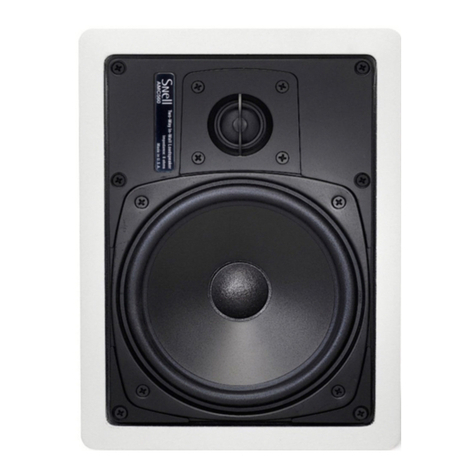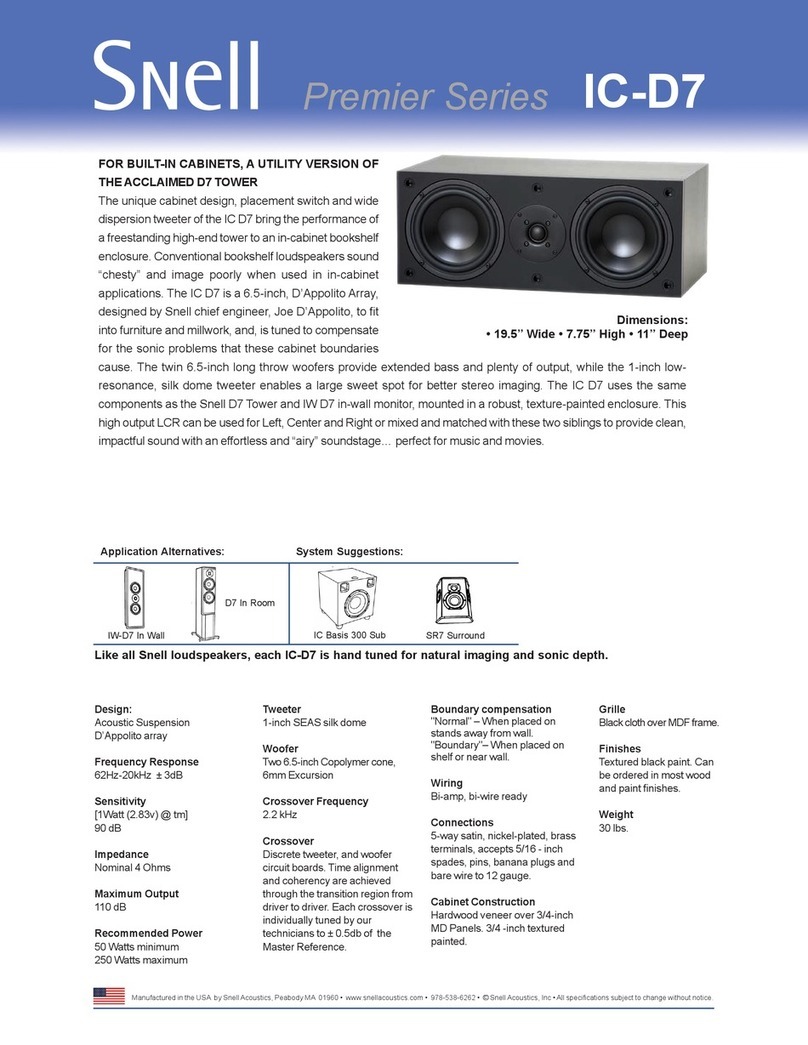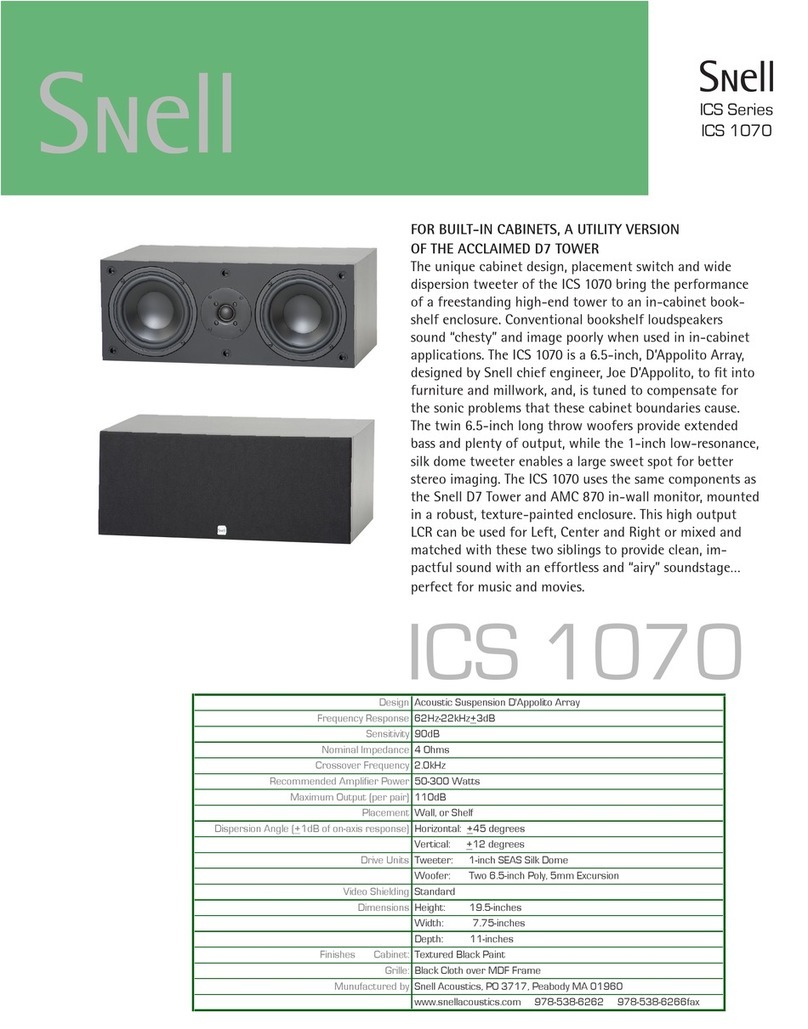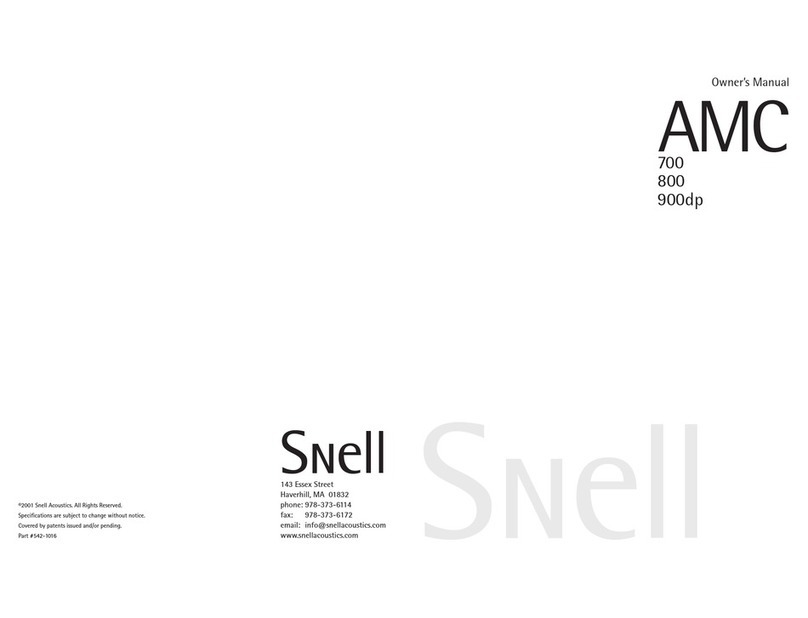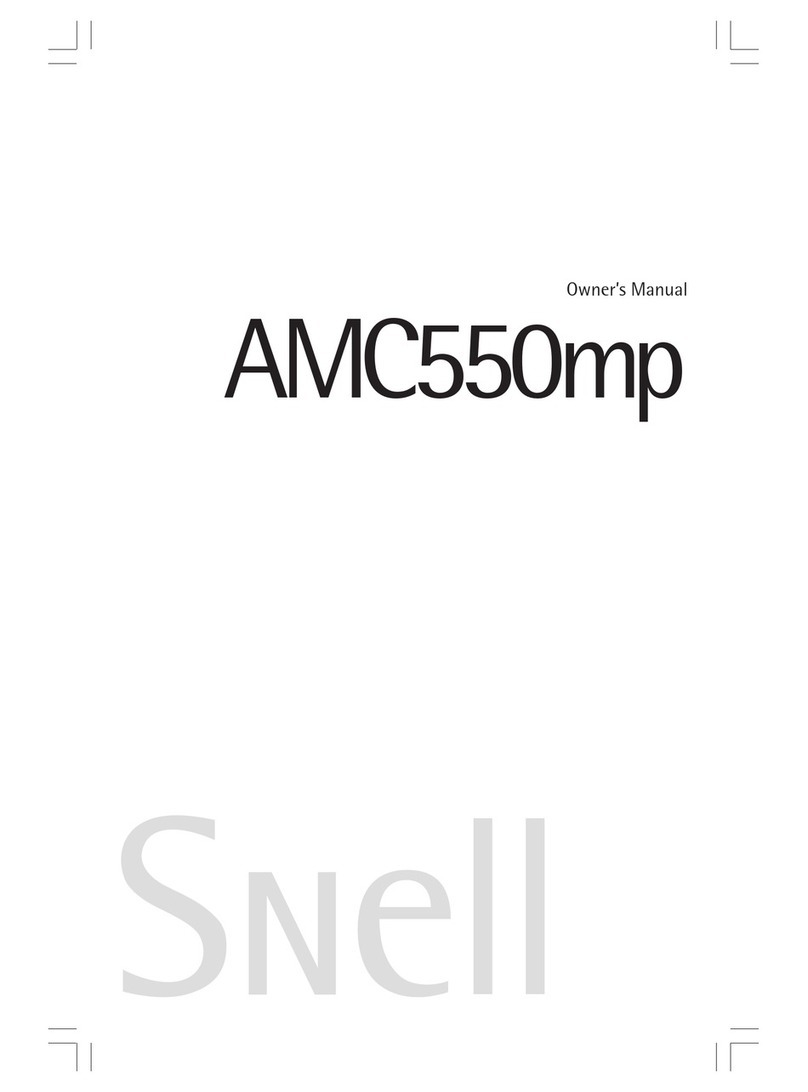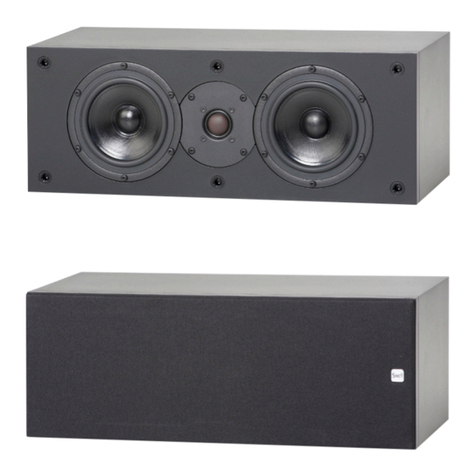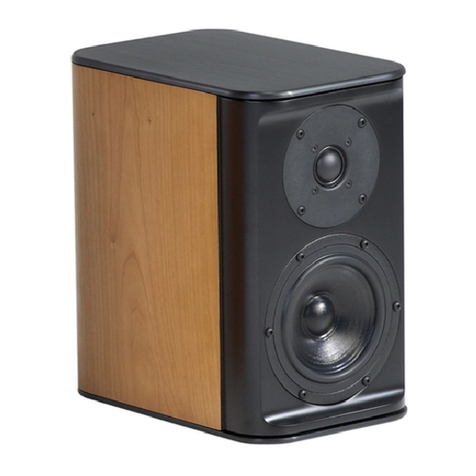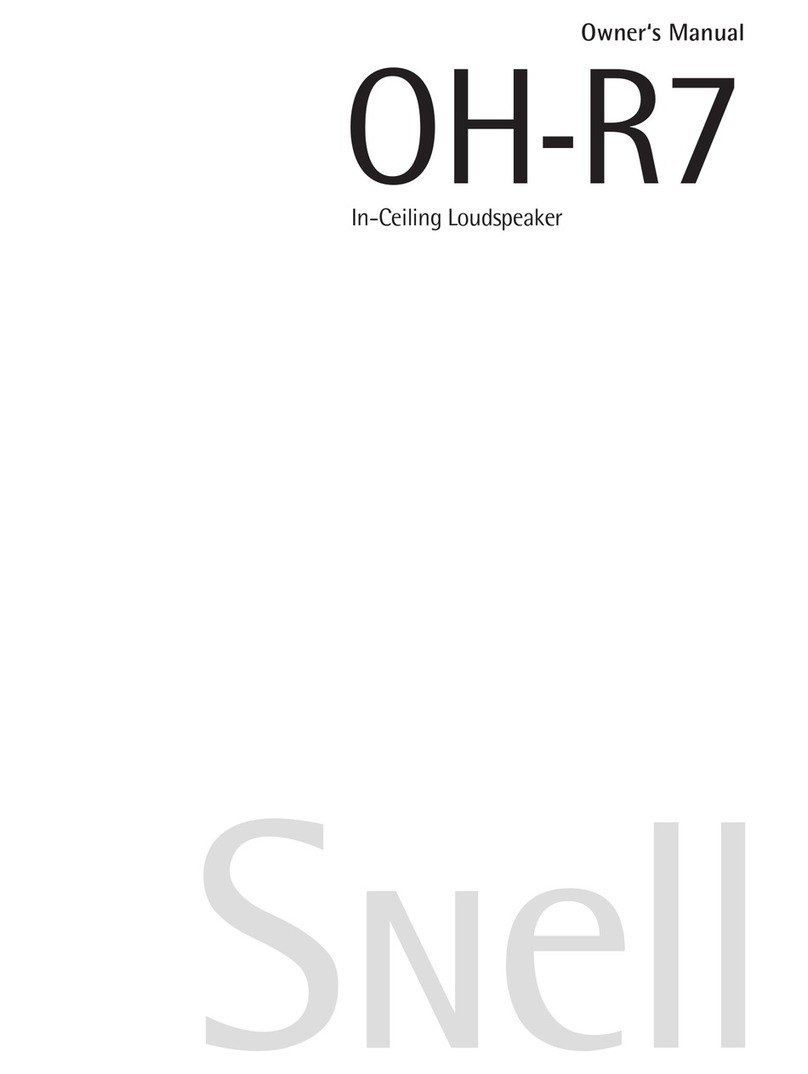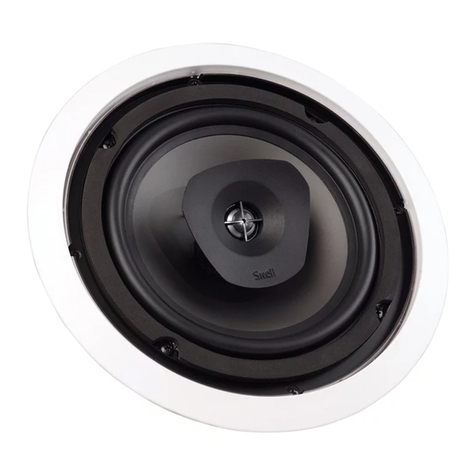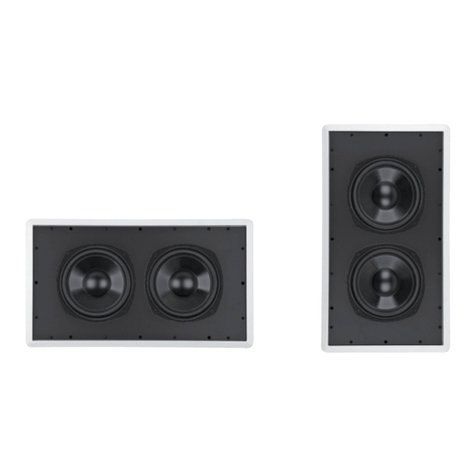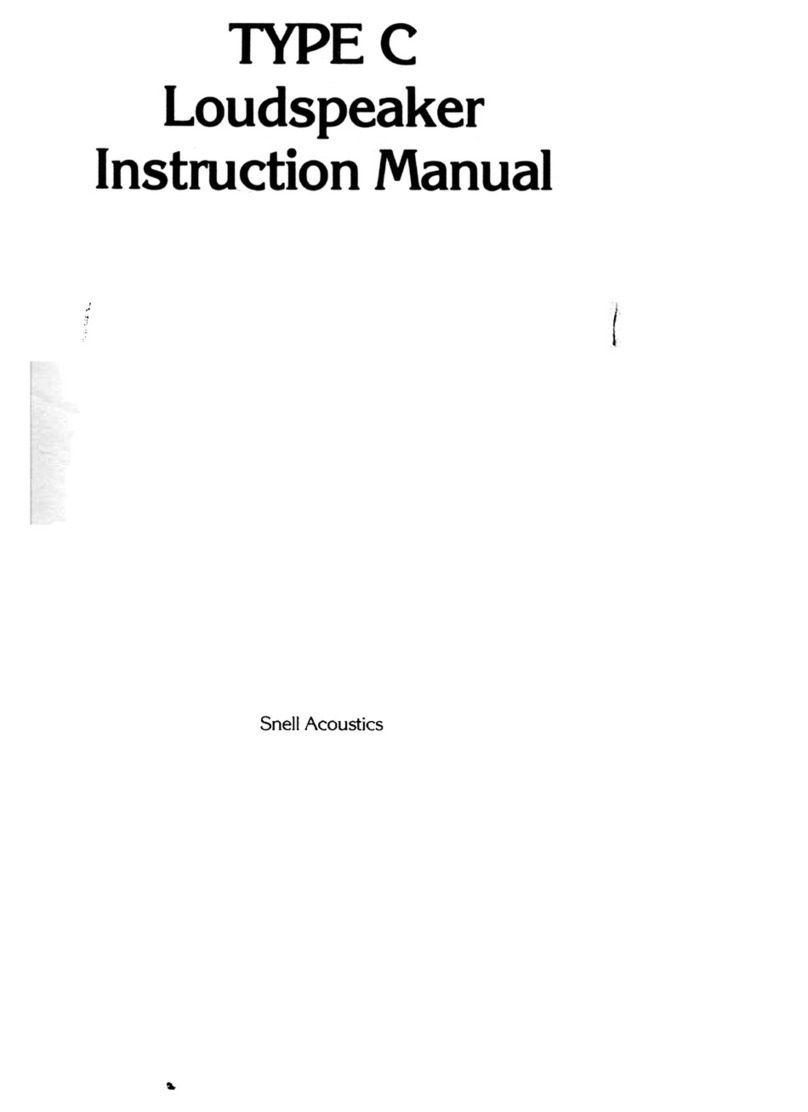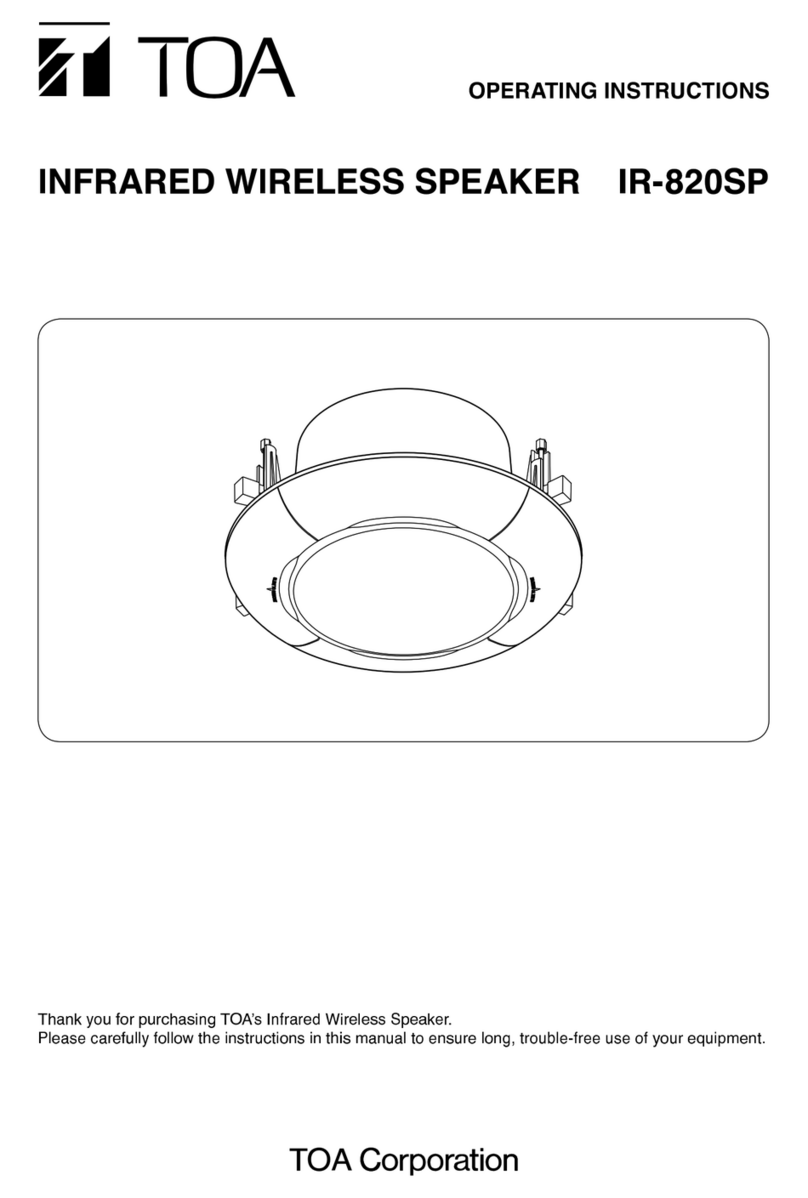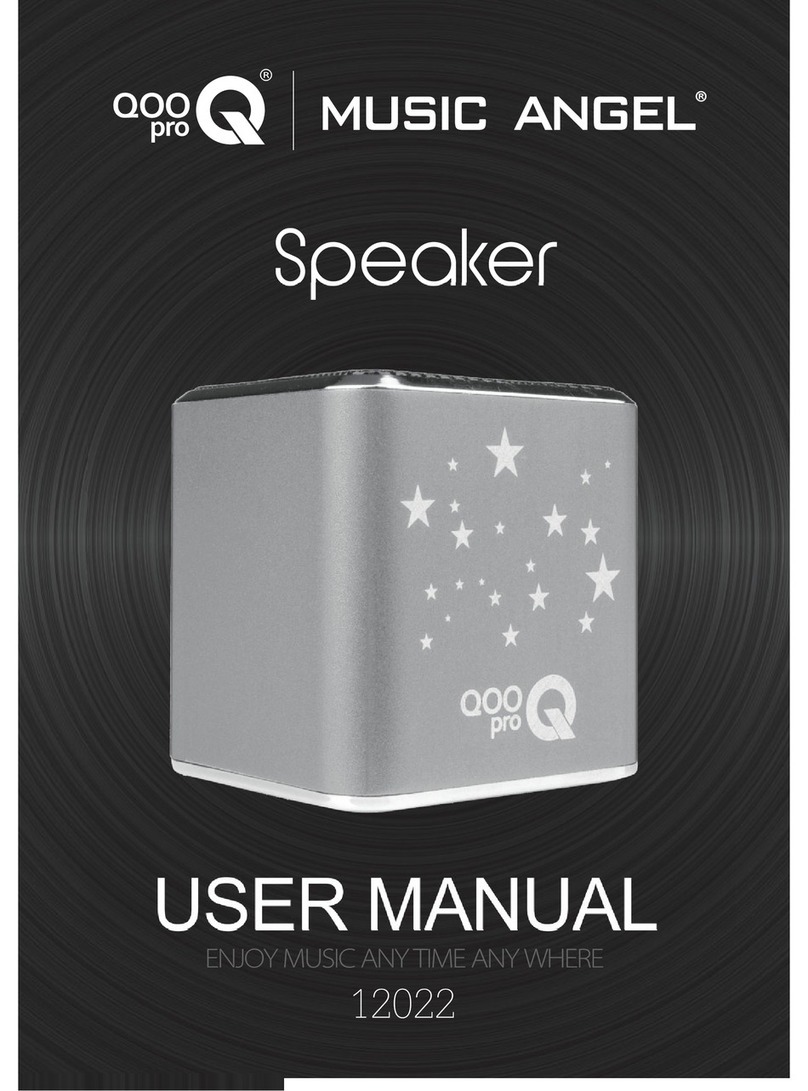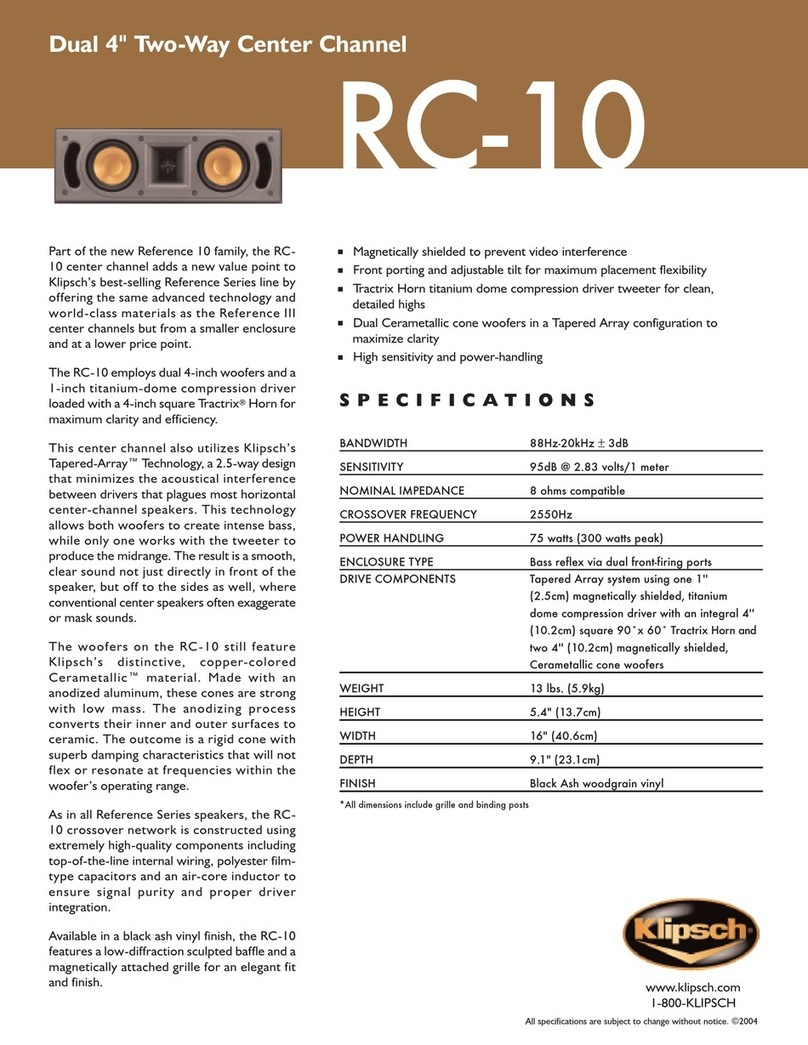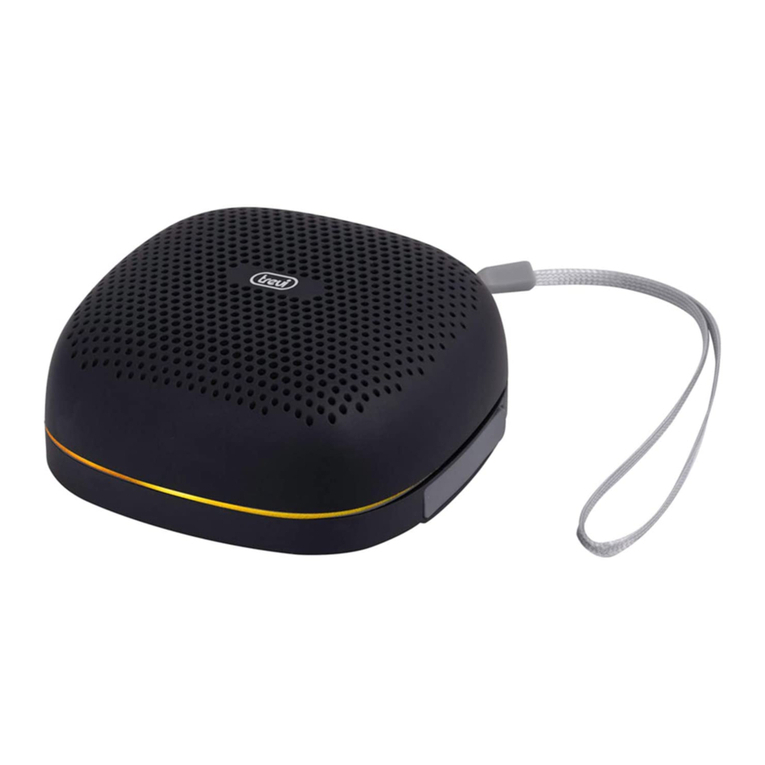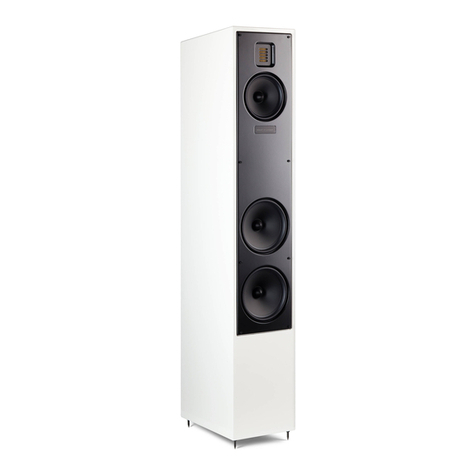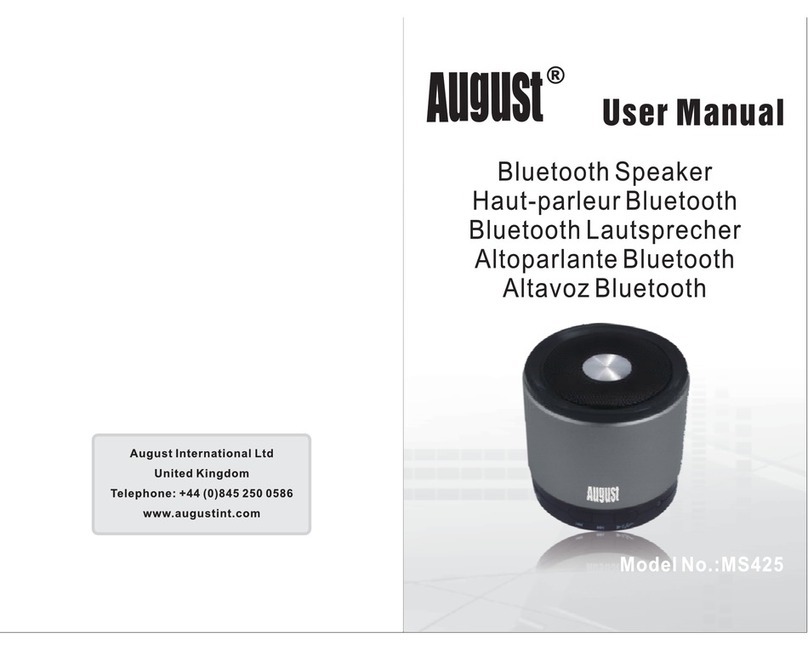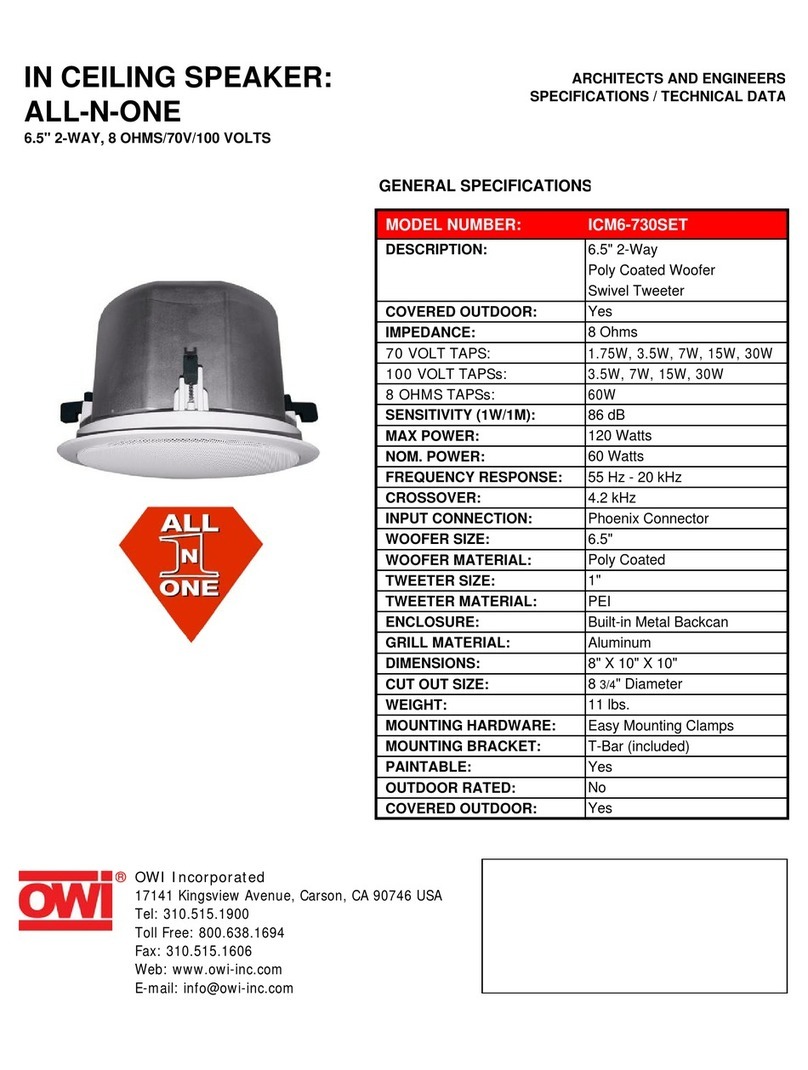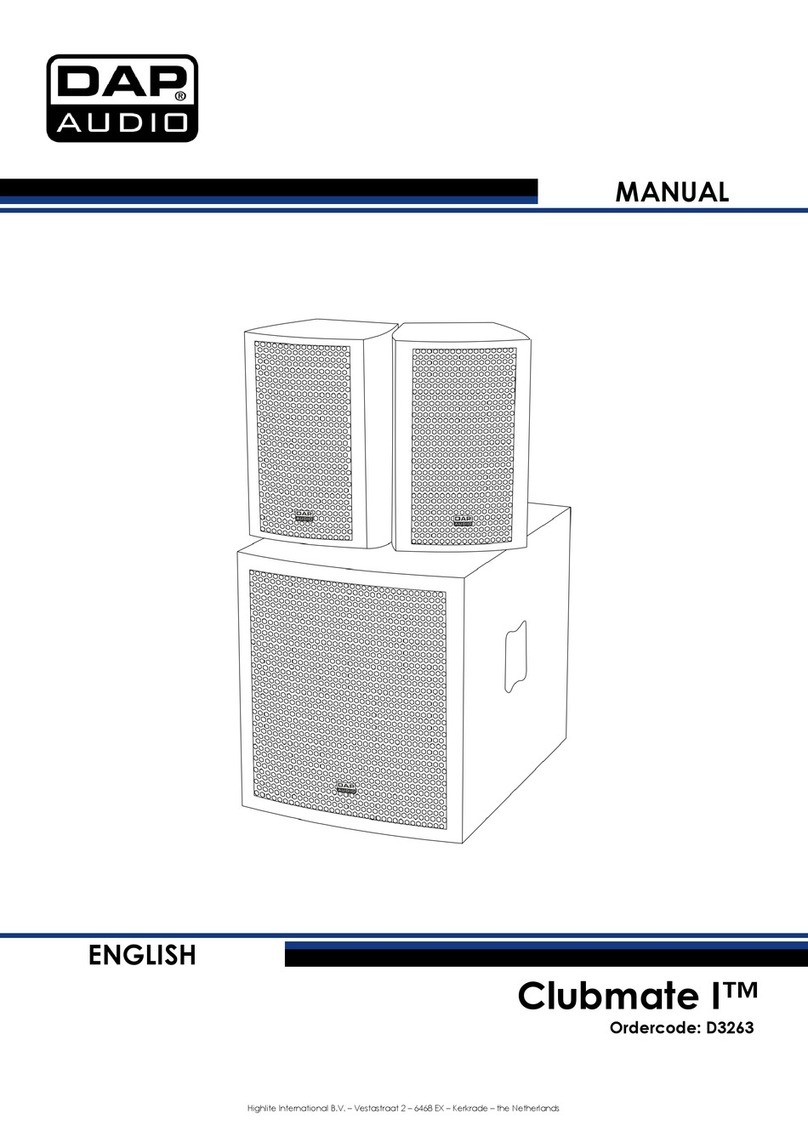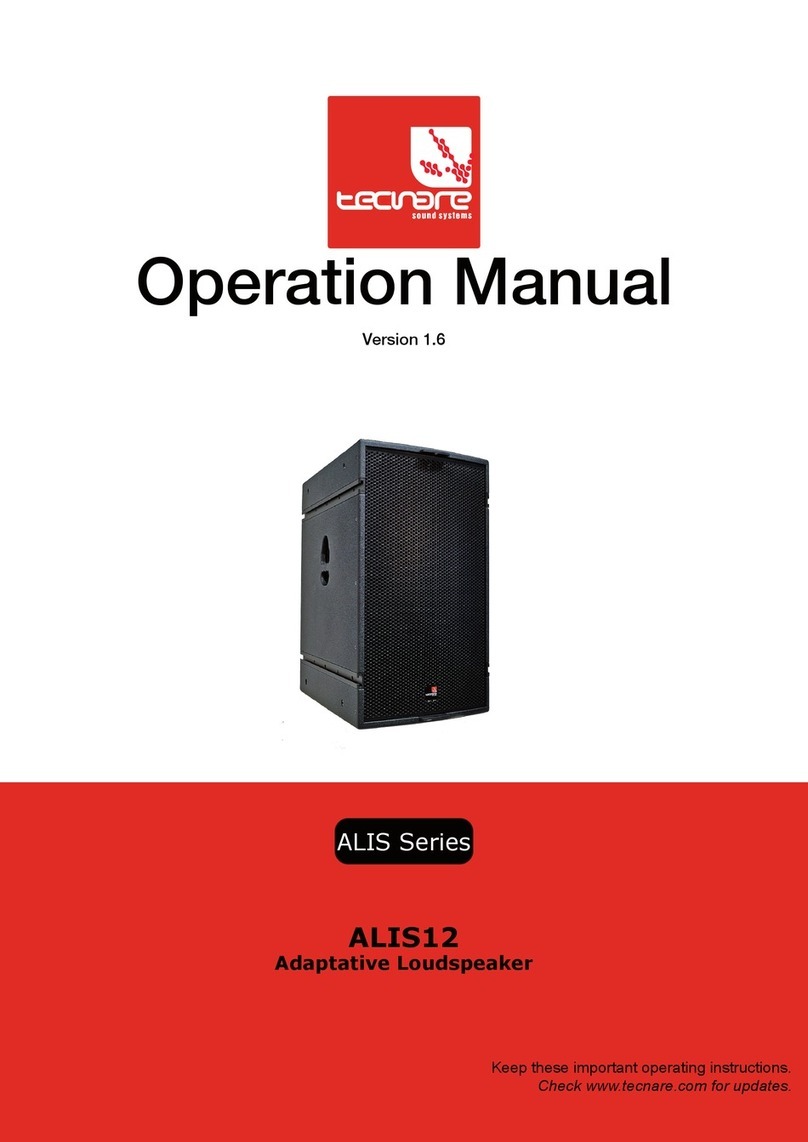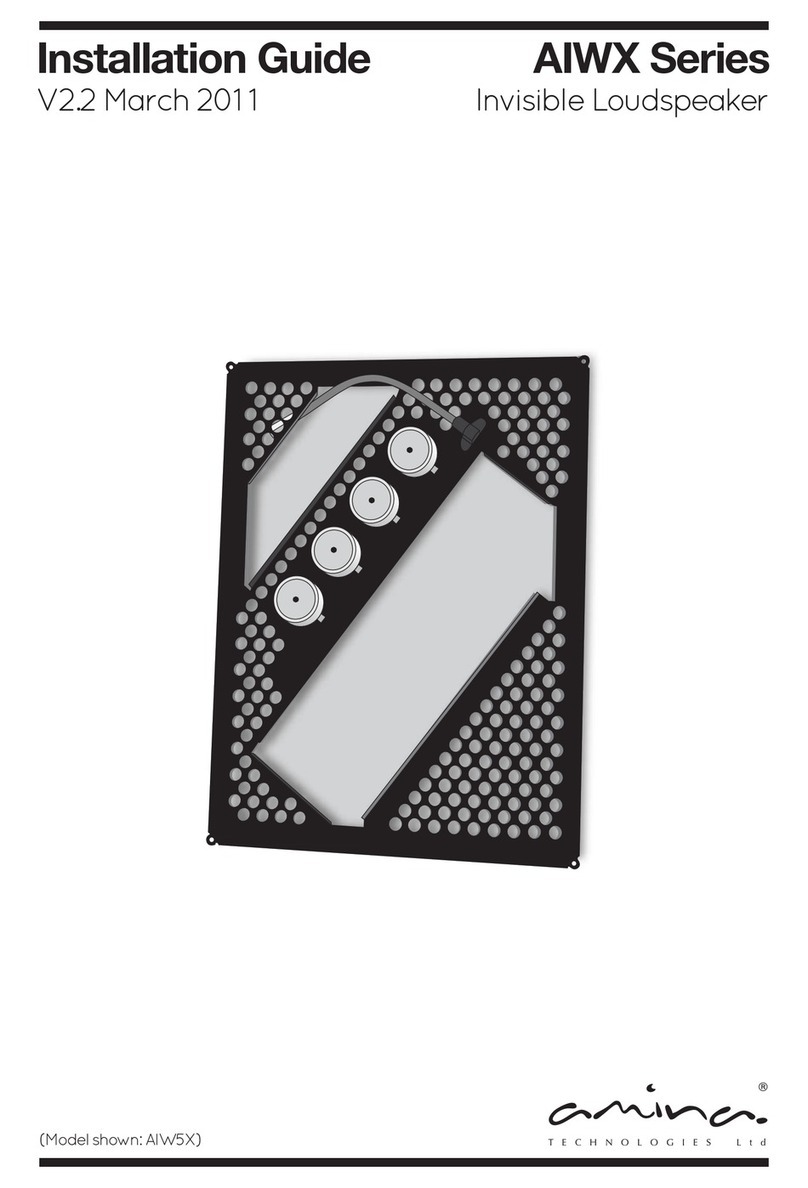Snell QBx 20 Monitor User manual

QBx
Owner’s Manual
15 Mini
20 Monitor
Center

2
Hand-Tuned
Crossover
6
1
/
2
" Video-Shielded
Bass Unit
"Butterfly"
Grille Cutout
Elliptical
Baffle Edges
1" Neodymium
Magnet Tweeter
High Loss
Sandwich Baffle
QBx Technology
SPECIFICATIONS QBx 20 Monitor
Frequency Response (±3dB) 65Hz–20kHz, -6dB @ 55Hz
Recommended Amplifier Power 15–150 watts (above 80Hz)
Nominal Impedance 6 ohms
Sensitivity (2.83v at 1m) 88dB SPL
Tweeter (video-shielded) 1-inch (25mm) black-anodized aluminum dome
with neodymium magnet structure and multi-
finned aluminum heatsink
Bass Unit (video-shielded) 61/2-inch (165mm) polymer chassis, HDA cone and
rubber surround
Cabinet Construction 3/4-inch MDF walls
Composite Baffle Construction 5/8-inch high density fiberboard, specialty
adhesive, and 5/8-inch high-density fibreboard
Grille Black cloth
Dimensions (HxWxD) 14 x 81/2x 10 inches
35.6 x 21.6 x 25.5cm
Weight 38 lbs (17.24kg) / pair
Finish Black Painted Oak, Cherry, others to special order

3
QBx Center
100 Hz–20kHz, -6dB @ 90Hz
15–150 watts (above 80Hz)
4 ohms
88dB SPL
1-inch (25mm) black-anodized aluminum
dome with neodymium magnet structure
and multi-finned aluminum heatsink
Dual 4 inch (100mm) polymer chassis, HDA
cone and rubber surround
3/4-inch MDF walls
5/8-inch high density fiberboard, specialty
adhesive, and 5/8-inch high-density fibreboard
Black cloth
53/4x 151/2x 8 inches
14.6 x 39.4 x 20 cm
14.5 lbs (6.58 kg) each
Black Painted Oak, Cherry, others to special order
QBx Mini
80 Hz–20kHz, -6dB @ 60Hz
15–150 watts (above 80Hz)
6 ohms
89dB SPL
1-inch (25mm) black-anodized aluminum dome
with neodymium magnet structure and multi-
finned aluminum heatsink
51/4-inch (130mm) polymer chassis, HDA cone
and rubber surround
3/4-inch MDF walls
5/8-inch high density fiberboard, specialty
adhesive, and 5/8-inch high-density fibreboard
Black cloth
113/4x 71/2x 10 inches
29.8 x 19.1 x 25.4 cm
29 lbs (13.16 kg) / pair
Black Painted Oak, Cherry, others to special order

4
PRODUCT DESCRIPTIONS
The QBx (“Quiet Box”) 20 Monitor is a high performance monitor loudspeaker for use in a wide
variety of applications. It is a two-way design that incorprates all the QBx technology features
— unique cabinet construction, superior drive units, and a complex crossover. The result is
exceptional with modest space requirements. The QBx 20 Monitor can be used as the main
speakers of a compact music system, the front and/or rear channel speakers of a surround
system, or an extension speaker in a multi-room system.
The QBx Center is tuned to match the tonal balance of the other QBx speakers — the QBx 25
Tower, the QBx 20 Monitor and the QBx 15 Mini. Seamless transitions between the QBx Center
and any combination of the other QBx speakers are guaranteed. Although the QBx Center is
primarily used as the center channel speaker in home theater applications, it also solidifies the
center sound image when used in audio-only reproduction. It employs a 21/2-way design with a
1-inch black anodized aluminum dome tweeter and two 4 inch bass units.
The QBx 15 Mini is the ideal choice for high performance sound when space is limited. When
used as a rear channel speaker, or as a front channel speaker in conjunction with the QBx Sub,
the QBx 15 Mini delivers tonal quality perfectly matched to the other QBx speakers. While the
QBx Mini is diminutive in size, it has the full complement of QBx cabinet, driver and crossover
technology.
QBx TECHNOLOGY
In an ideal speaker, the speaker cabinet is inert and resonance free. It should have smooth
contours without projections that cause reflections which degrade high frequency response. In
short, the cabinet should not negatively affect the sound of the loudspeaker. QBx (Quiet box)
refers to a number of techniques that reduce the detrimental effects that typically come from
the resonances and reflections of ordinary cabinets.
“Butterfly” grille cutout
The necessary cutout area around the tweeter is given a highly irregular contour to prevent the
irregular high frequency response that would otherwise occur. The contour expands and
contracts around the perimeter of the tweeter, creating a “butterfly” shape.
Elliptical baffle edges
The grille is mounted flush into the baffle. The baffle edges have large elliptical radiuses. This
smooths the cabinet termination, greatly reducing the edge reflections. High frequency
smoothness is preserved.
High-Loss Sandwich Baffle
The unique high-loss baffle is constructed from multiple layers of wood and a high tech
adhesive. The “lossy” adhesive that laminates the two layers of speaker baffle greatly reduces
cabinet resonances, resulting in purer midrange and clean, crisp bass.
Hand-Tuned Crossover
The crossover networks were designed using sophisticated computer simulation. Final system
balance is determined by exhaustive listening tests. These networks adhere to an “in-phase” or
Linkwitz-Reilly design: time alignment and coherency are maintained through the transition
region from driver to driver. In production, each crossover is individually tuned by technicians
to within ±0.5dB of the Master Reference, ensuring predictable performance in your home.

5
Drive Units
The QBx 20 Monitor and QBx 15 Mini both use a 1-inch black-anodized aluminum dome
tweeter with a multifinned aluminum heatsink. The QBx 20 has a 61/2-inch bass unit that has a
High Definition Aerogel cone. The QBx 15 has a 51/4-inch bass unit made with the same cone
material.
The QBx Center uses the same tweeter as the QBx 20 Monitor and QBx 15 Mini. Bass is
provided by dual 4-inch bass units that have HDA cones and rubber surrounds.
All three models feature a video-shielded driver complement, providing unlimited placement
options.
HOW TO PLACE YOUR SPEAKER SYSTEMS
Front Speaker Separation
The distance between the front speakers determines the width of the stereo image. If the
speakers are placed too close together, the image will be too narrow; too far apart and the
blend will suffer, creating a hole in the middle. When properly placed, your speakers will create
a continuum of “virtual images” from left to right, with an illusion of sound outside, in front,
and behind the speaker systems.
We recommend an angular separation
of about 50 degrees (when viewed from
above). This is equivalent to a
separation between the speaker
systems that is about 85% of the
distance from the speakers to the
listener location.
Note: When the front speakers are part of a
home theater system that also has a center
channel speaker, the distance between the
front speakers can be somewhat greater
than what is recommended here.
Speaker Distance
Creation of sound between the speakers requires precise placement. The front left and right
speakers should both be the same distance from the listener location. We advise using a tape
measure to equalize these two distances to the primary listening position. The results will be
well worth the time and effort.
Aiming the Front Speakers
Your Snell speakers are designed to produce a very smooth response over as wide a range of
radiated angles as possible. Like all speakers of this type, the response evenness is maintained
over a wider horizontal arc than vertical (assuming the long box dimension is vertical). Take
this into account when placing and aiming your speakers.
If the speakers are mounted very high or very low, aim the center of the speaker toward
your ear level while listening in a seated position.
If this is not possible, it may be preferable to place the speakers on their sides.
Distance Between Speakers
Distance to Listening Area
50°

6
Front Speaker Toe-In
“Toe-in” refers to the angling of the speaker systems toward the listener location. Toe-in is a
matter of taste. As the degree of toe-in increases, the stereo effect becomes more direct-
sounding, like a pair of headphones. Speakers not toed-in will give a more diffuse sound with a
less defined central image.
Location Affects Bass
As speakers are moved closer to rigid room boundaries — the walls, the floor, and the ceiling —
the deep bass part of the sound range is accentuated. However, if speakers are too close to the
room boundaries, particularly corners, the bass output can be uneven. Experiment until you
find the best overall sound for your room. Choose a musical selection with a strong, continuous
bass line. Repeat a short section until you have a firm impression of it in your mind, then try
another speaker location. Repeat this process until you are content with the bass response you
are getting. Moving your listening position will affect the sound as much as moving the
speakers. Try different listener locations as well as speaker locations.
Surround Speaker Placement
When the QBx 20 Monitor or QBx 15 Mini is used as rear channel surround speakers, they
should be placed where they will produce a diffuse sound field. Your attention should not be
drawn to the speakers, nor should you be able to audibly locate the speakers.
Mount the speakers above the listener
location.
The speakers should be to the sides of
or behind the listener location.
These placement recommendations
minimize the chance you will be able to
audibly locate the speaker. Setting the
front-to-rear balance of the system is also
very important. Many audio/video
components have built-in signal generators
that can help you set the proper balance.
See the instruction manuals for your
associated components for more informa-
tion.
Recommended surround speaker placement options

7
The QBx 20 Monitor Placement Switch
In some situations it may be best to position the QBx 20 Monitor in a location that does not
produce the best overall sound balance. A common example is in audio/video installations
where, in order get the best sound image, the speakers must be placed next to a large cabinet
or big screen television. This can cause uneven response in the upper bass and lower midrange
which can make voices sound unnatural. The QBx 20 Monitor features a Placement Switch,
located in the upper left corner of the terminal cup, that can help restore smooth response in
such situations.
If the QBx Monitor is located
where it has at least 12
inches (30cm) of clearance on
three sides, use the Normal
switch setting. If it is placed
next to a large object, try the
Boundary switch position to
see if it results in smoother
response.
BoundaryFree Standing
12"/30cm
or more
BoundaryFree Standing
12"/30cm
or more
QBx Center Placement
As its name implies, the QBx Center is designed to keep dialogue or soundtrack information
centered. Therefore, its placement relative to the left and right speakers is critical.
Place the QBx Center on top of or beneath
your TV, with its front edge as far forward
as practical. Try to keep the front of the
speaker flush with the front of the screen.
Try to place all front speakers at approxi-
mately the same height. If possible, the
center speaker height should be within 2
feet (60cm) of the height of your left and
right speakers.
If you need to place the speaker any higher
or lower, angle it toward ear level. If this is
not possible, place the speaker on its side
for best results.

8
CONNECTING THE SPEAKERS
Warning! To prevent electrical shock, always switch off the amplifier or receiver when making
connections to the speaker system.
Choosing cable
We recommend 16 gauge cable or thicker for runs up to 25 feet (8m) and 12 gauge wire or
thicker for longer runs. (We use a custom-configured 12 gauge oxygen-free cable in our
crossover networks.)
Connecting with bare wire:
Insert bare wire into holes and tighten.
Connecting with banana plugs, pins or spade lugs:
The gold-plated binding posts accept standard banana plugs and
pins, and can accommodate spade lugs to 5/16-inch.
QBx 20 Monitor
amplifier or receiver
Basic Connections — QBx 20 Monitor, QBx 15 Mini
and QBx Center
The QBx 20 Monitor is shown in the connection
illustration. The QBx 20 Monitor has dual conection
terminals that allow bi-wiring and bi-amplifying.
The QBx 15 Mini and QBx Center each have a single
pair of terminals, but are connected in the same
way. (Ignore references to terminal jumper straps.)
Keep the speaker terminal jumper straps on the
QBx 20 Monitor in place.
When making connections, be sure to connect
+ to + (red) and – to – (black).
QBx 20 Monitor
amplifier or receiver
speaker terminal
jumper straps
Bi-Wiring — QBx 20 Monitor only
Use equal lengths of the same kind of cable
when bi-wiring each speaker.
Unscrew both sets of terminals and remove
the jumper straps.
When making connections, be sure to connect
+ to + (red) and – to – (black).

9
Bi-Amplifying — QBx 20
Monitor only
Using One Amplifier for the Bass
and One for the High End
Unscrew both sets of terminals
and remove the jumper straps.
Connect the cables from the
bottom set of terminals to the
amplifier driving the bass unit.
Connect the cables from the
top set of terminals to the
amplifier driving the tweeters.
When making connections, be
sure to connect + to + (red)
and – to – (black).
Do not use an external
crossover. It will interact with
the phase and frequency
response of the QBx.
Left QBx 20Right QBx 20
right channel amplifier left channel amplifier
Left QBx 20Right QBx 20
low frequency amplifier
high frequency amplifier
Using One
Amplifier for Each
Speaker
Use two
identical
amplifiers.
Unscrew both
sets of
terminals and
remove the
jumper straps.
Connect the
cables from the
bottom set of
terminals to the
first amplifier’s
right channel.
Connect the cables from the top set of terminals to the first amplifier’s left channel.
Repeat steps 2 and 3 for the second amplifier.

10
Using With a Multichannel Surround Processor
When using a subwoofer:
Select the SMALL setting on your receiver or processor for your main and center channels.
This routes all bass information (typically below 100Hz) to your subwoofer.
When not using a subwoofer:
Select the LARGE setting on your receiver or processor for your main speakers. This routes
all bass information (typically below 100Hz) to your main speakers. Otherwise, bass
information will be lost.
Matching the sound levels of each speaker:
Your home theater system most likely includes a test signal that simplifies level matching.
Refer to the instructions provided with these electronics.
HOW TO CARE FOR YOUR SPEAKERS
Use a soft terry cloth towel slightly dampened with water, glass cleaner, or a diluted mild
detergent. The towel should be just damp enough to wipe the surface clean without
leaving a trail of moisture.
Do not use abrasive cleaners or any cleaner containing chemicals harsher than those
found in glass cleaner.
LISTENING LEVELS AND POWER HANDLING
The power recommendation for the system assumes you will operate the amplifier in a way
that will not produce distortion. All speakers can be damaged by even a modest amplifier
if it is producing distortion. If you hear a gritty noise or other signs of strain, turn down
the volume. Prolonged or repeated operation of your speakers with a distorted signal can
cause damage that is not covered by the warranty. It is especially important that you do
not overdrive the bass capability of smaller speakers. Watch for noises, such as pops,
caused by the music’s bass line. Use of the loudness control and/or full bass boost at
louder volumes is likely to overdrive the woofer. Use such controls sparingly.

11
LIMITED WARRANTY
For five years from the date of purchase, Snell Acoustics will repair for the original owner any
defect in materials or workmanship that occurs in normal use of the speaker system, without
charge for parts and labor.
Your responsibilities are to use the product according to the instructions supplied, to provide
safe and secure transportation to an authorized Snell Acoustics service representative, and to
present proof of purchase from an authorized Snell dealer in the form of your sales slip when
requesting service.
Excluded from this warranty is damage that results from abuse, misuse, accidents, shipping,
repairs, or modifications by anyone other than an authorized Snell Acoustics service representa-
tive. This warranty is void if the serial number has been removed or defaced.
This warranty gives you specific legal rights, and you may also have other rights that vary from
state to state.
If Service Seems Necessary
Contact the dealer from whom you purchased the speaker system. If that is not possible, call us
at 978-538-6262, or write to:Snell Acoustics
300 Jubilee Drive, PO Box 3717
Peabody, MA 01961-3717
We will promptly advise you of what action to take. If it is necessary to return your speaker
system to the factory, please ship it prepaid in the original factory packaging. Please note that
Snell Acoustics will not be held liable for shipping damage due to improper packaging. After it
has been repaired, we will return it freight-prepaid in the U.S. or Canada.

300 Jubilee Drive, PO Box 3717
Peabody, MA 01961-3717
phone:978-538-6262
fax:978-538-6266
email: [email protected]
www.snellacoustics.com
©2000 Snell Acoustics. All Rights Reserved.
Specifications are subject to change without notice.
Covered by patents issued and/or pending.
Part #542-1013
This manual suits for next models
2
Other Snell Speakers manuals

Snell
Snell SR.5 Surround User manual
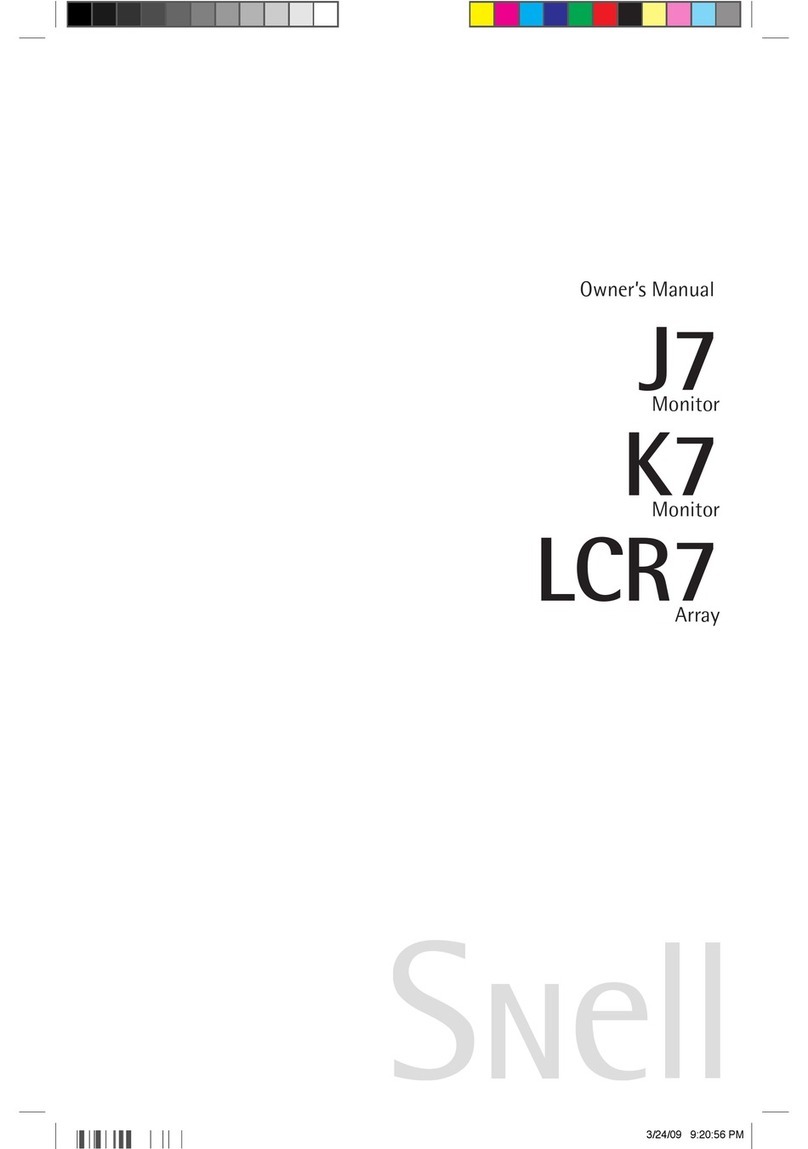
Snell
Snell J7 User manual
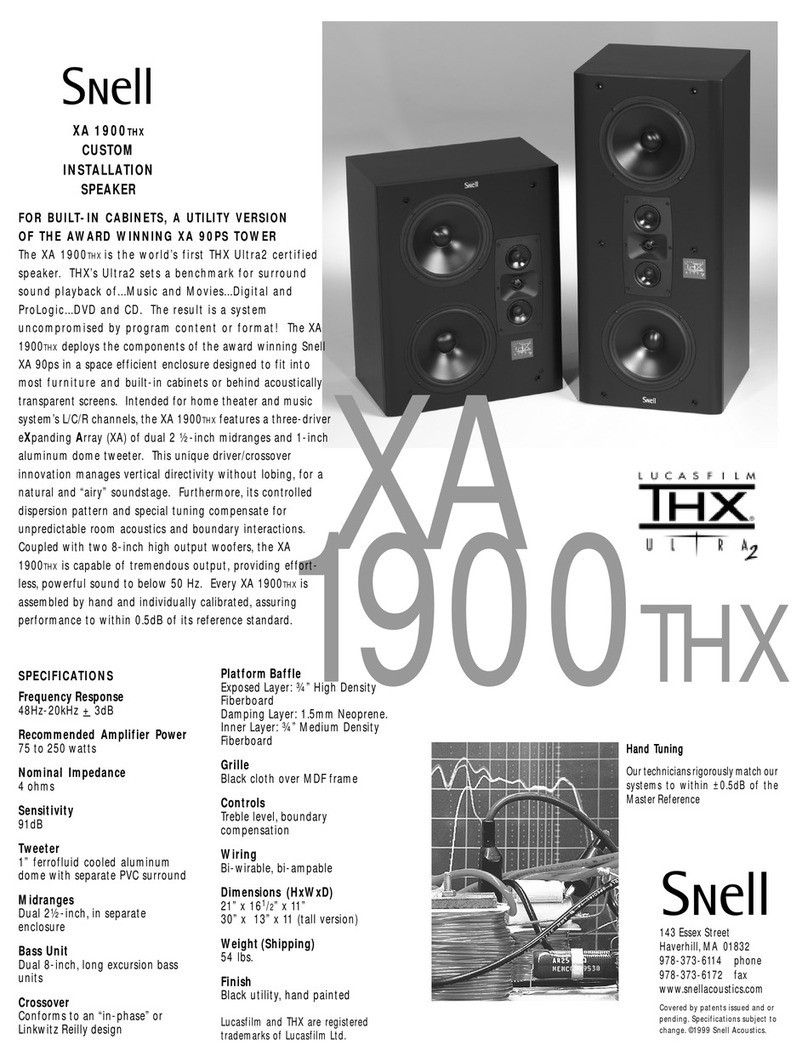
Snell
Snell XA 1900THX User manual

Snell
Snell CLS.5 User manual
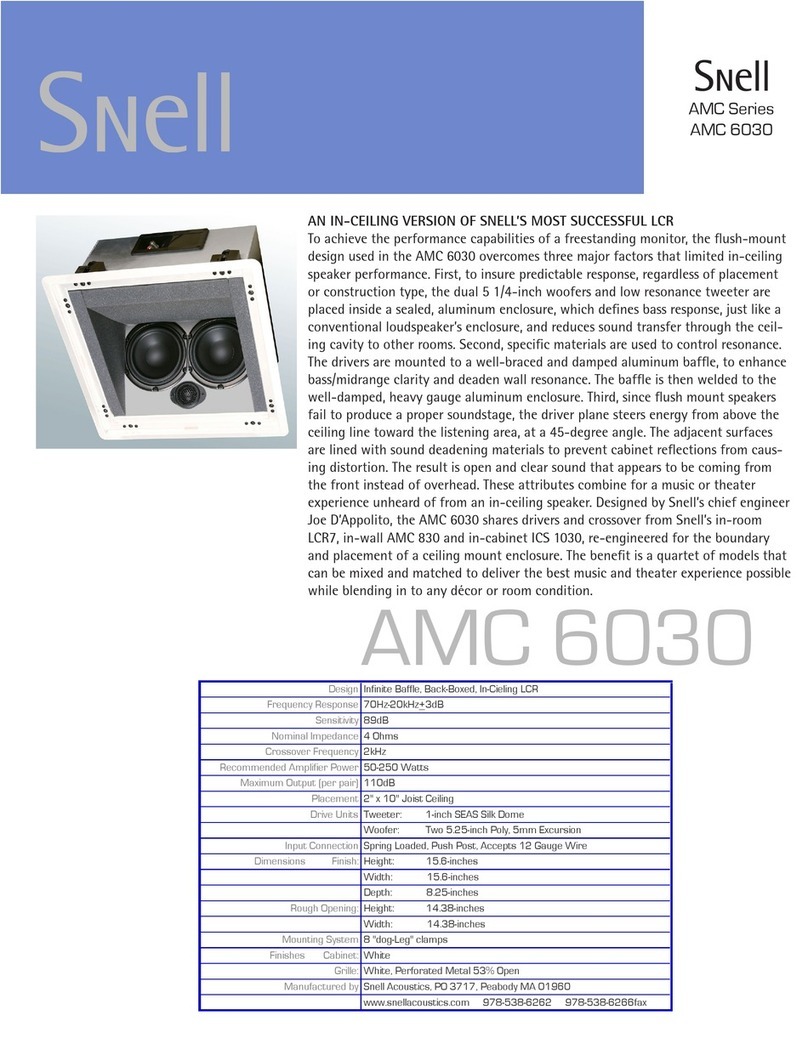
Snell
Snell AMC 6030 User manual
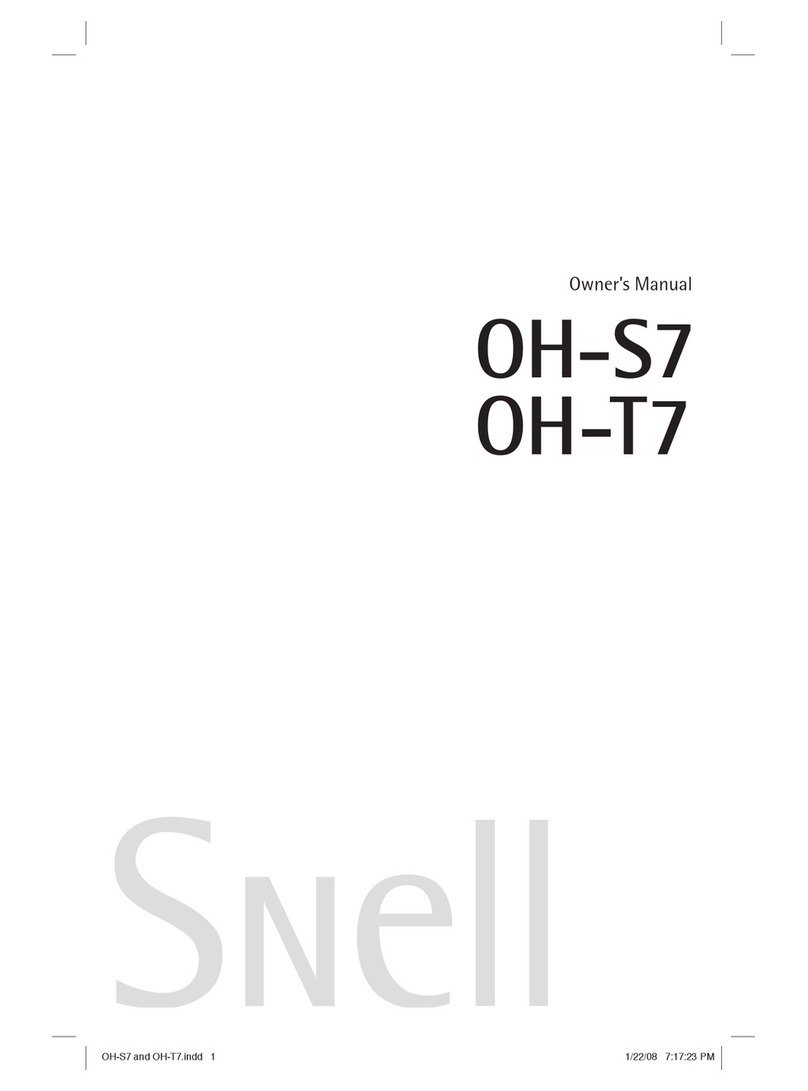
Snell
Snell OH-S7 User manual
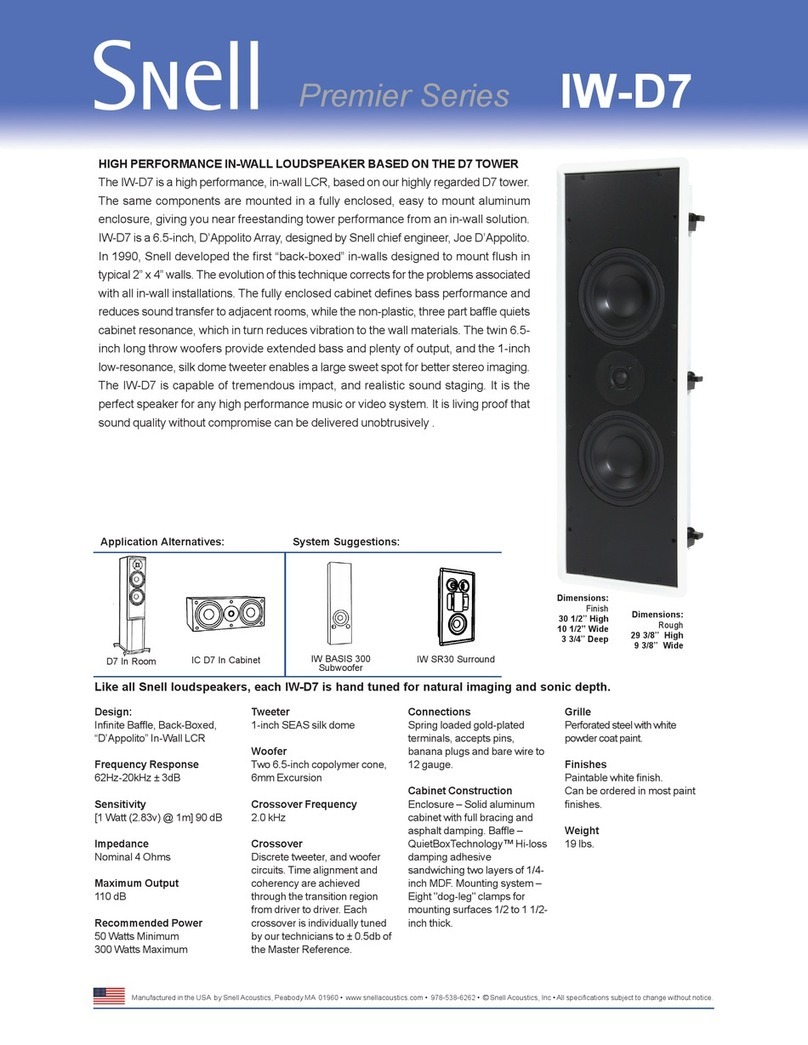
Snell
Snell IW-D7 User manual
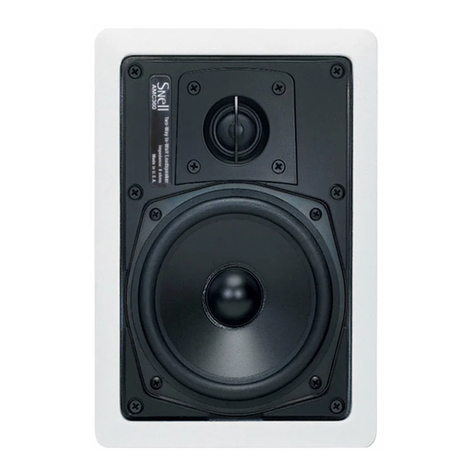
Snell
Snell AMC 360 User manual
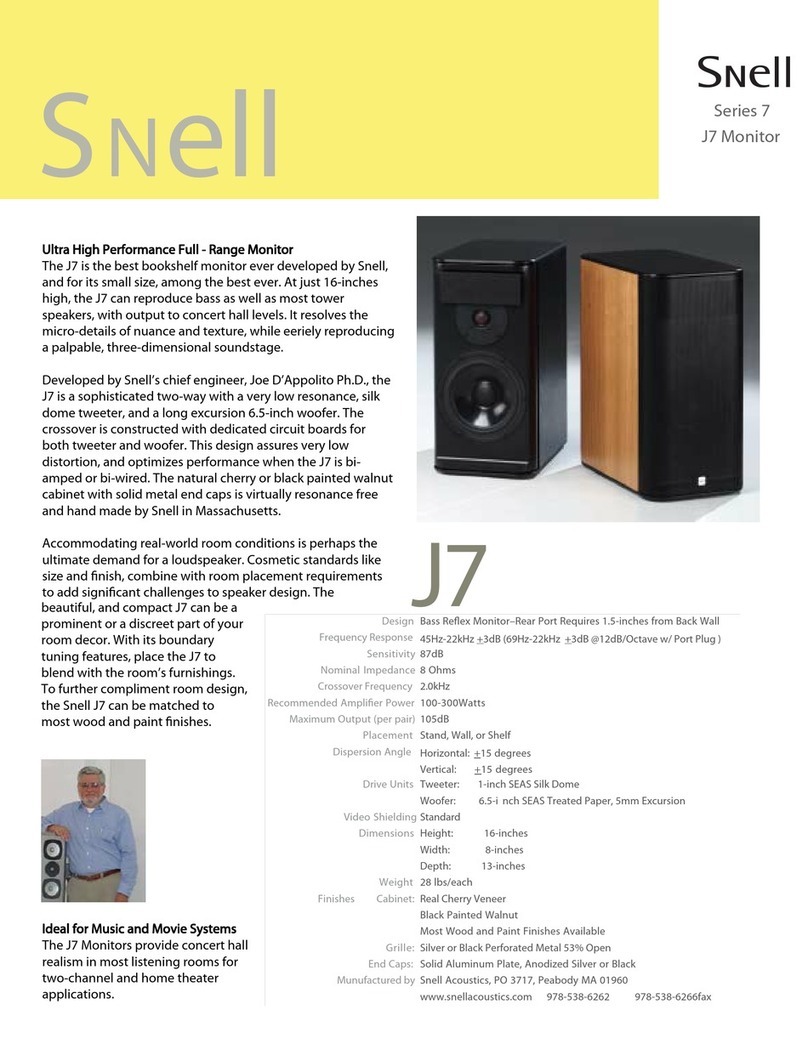
Snell
Snell SR7 Series 7 User manual
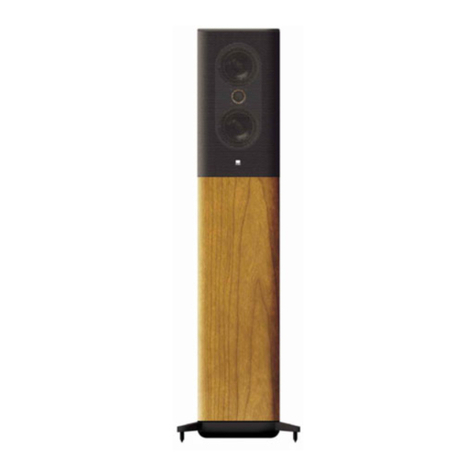
Snell
Snell IC-B7S User manual

